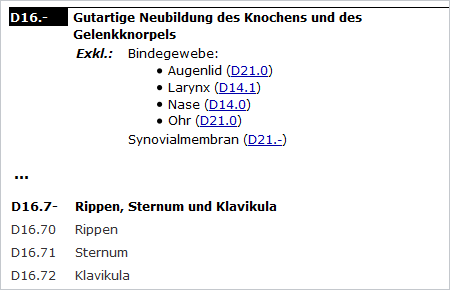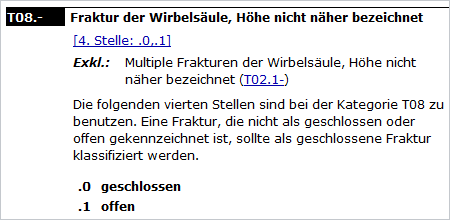Category and Code
ICD-10-GM codes have a maximum of five digits and are alphanumeric. Each code starts with a capital letter followed by a purely numeric sequence.
The purpose of the following explanations on categories, class titles and codes as well as on inclusion notes and exclusion notes and other class attributes is to provide an initial understanding of ICD-10-GM. Encoding requires knowledge of the "Anleitung zur Verschlüsselung" (Encoding instructions) in the preface to ICD-10-GM as well as the German Coding Guidelines for G-DRG case-based fixed sum system ("Deutsche Kodierichtlinien" DKR) and for PEPP payment system ("Deutsche Kodierichtlinien für Psychiatrie und Psychosomatik" DKR-Psych).
Category, class title and code
The central element of ICD-10-GM Tabular List is the three-character category or three-character code. The designation of a category is known as the class title. The class title is allocated a three-digit alphanumeric notation, the code; in print, it appears on a black background.

The term "code" is often used synonymously with "category".
Some of the three-digit categories, such as "A38 Scharlach" (Scarlet fever) represent individual pathological conditions; however, in general, one three-character category comprises several diseases with similar characteristics, for example: D 27 refers to benign ovarian neoplasms. On this level, "and" in the class title stands for and/or, square brackets contain synonyms and round brackets optional additions.
The descriptions included in a particular category of the Tabular List are not final; they serve as examples for the content of that category and as an indication of its scope and delimitation. To that end, preferred terms are used. By contrast, in addition to these preferred terms, the associated Alphabetical Index also contains many other currently used diagnostic terms, including synonyms.
Very few categories have a structure as simple as that of D27. Code and class title can be supplemented with subcategories and class attributes.
Three-, four- and five-character categories
Almost all categories have four- or even five-character subcategories, identifiable from the point-dash notation of the three-character code.

The fourth and fifth digits are separated from the three-character code by a decimal point. Their values can range between 0 and 9, but not all values have to be used. In most of the cases 8 stands for "other specified" conditions, 9 for "other non-specified" within this category. Codes without subcategories are referred to as terminal codes. The basic rule is to encode as specifically as possible, i.e. to use subcategories if available within a category. The following example shows subcategory D16.7- of category D16.-. Four- or five-character codes explicitly named in the Tabular List, as in this example, are known as precoordinated codes.

Postcoordinated codes of ICD-10-GM
Some of the four- and five-character subcategories are not explicitly included as four- or five-character codes in the print and HTML version (book version) of the Tabular List, but have to be assembled by the encoder on the basis of encoding notes and a subclassification list of possible values for the fourth and fifth digit. In the following example T08.- "Fraktur der Wirbelsäule, Höhe nicht näher bezeichnet" (Fracture of spine, level unspecified), the three-character code is complemented with 1 in fourth place to indicate an open ("offen") fracture; if the fracture was closed ("geschlossen") or no specific information available, the fourth digit would be 0. An "open distal fracture of the spinal column, level unspecified" is thus encoded as T08.1.

Codes generated in this manner are referred to as postcoordinated codes. There are also some few codes that can be used for two different subclassifications, e.g. for the E10-E14 group, for which both the fourth and the fifth digits are generated from individual subclassifications. A subclassification referring to an entire chapter or a whole block of categories is placed to preface the chapter or block and cross-referenced in the individual categories.
Primary, additional and optional codes
Most codes do not contain any special digits other than the point or dash where applicable. They are socalled primary codes and can be used by their own. However, there are three special kinds of codes, indicated with a dagger, an asterisk or an exclamation mark. Asterisk and exclamation mark codes are so called secondary codes and they must never be used on their own but have to be combined with a primary code.



Normally, ICD classifies each pathological condition under a single aspect, i.e. each condition is allocated exactly one code. The dagger-and-asterisk system permits the classification of a disease under two different aspects, i.e. according to its aetiology and its manifestation. The disease is then assigned a combination of a dagger code for aetiology and an asterisk code for manifestation: A17.9+ G99.8*. For detailed information and examples of the dagger-and-asterisk system, please turn to the encoding instructions in the preface of ICD-10-GM..
Dagger codes: Primary codes
Dagger codes classify according to aetiology. Dagger codes are primary codes; this means that they can be but do not have to be combined with an asterisk code. Frequently, the dagger code is supplemented with the optional asterisk code. Apart from codes marked as dagger codes, each random primary code can be used as an aetiology code and combined with an asterisk code. In this case, the aetiology code is marked with a dagger by the encoder.
Asterisk codes: Additional codes
Asterisk codes designate the manifestation of a disease. As additional codes, they must never be used on their own but only as part of a dual encoding in the "dagger and asterisk" system, i.e. always in conjunction with a dagger code or another primary code. Very often, the corresponding dagger code is given for an asterisk code.
Exclamation mark codes: Optional codes
Exclamation mark codes are optional codes. They must never be used on their own, but only in addition to a primary code, i.e. a code not marked with * or !. Their purpose is to further specify the condition encoded with the primary code.
Class attributes: definitions, inclusion notes, exclusion notes and others
Chapters, blocks and categories often include a range of clarifying comments. If such class attributes follow a chapter title, they apply to all categories within the chapter, if they follow a block title, they apply to all categories within the block, if they follow a category title, they apply to the category and all of its subcategories.
Definitions
Occasionally - particularly in Chapter V - definitions are provided immediately underneath the class title for the clinical characteristics referred to in the class title.

Inclusion and exclusion notes
Inclusions and exclusions indicate which diseases fall into a certain category and which do not. Inclusion terms are often but not always indicated by "Inkl." (for inclusive) preceding the name of the disease. Exclusion terms can always be identified by a preceding "Exkl." (for exclusive). For diseases mentioned under exclusions, the code of the applicable category is given in round brackets.
As for class titles, for inclusion notes, too, additional optional terms can be provided in round brackets. In the following example I10.-, the inclusion diagnosis of "Hypertonie" (Hypertension) always falls into the I10.- category, completely irrespective of whether the term "Hypertonie" is specified by one or more of the expressions included in brackets.

Lists and tables
For inclusion notes and exclusion notes, lists can be included for a particular term, as e.g. for I10 or I24.0; the term as list heading is separated from the list by a colon. The list heading can be the name of a disease or an incomplete sentence as in I10, but also a single adjective such as "akut" ("acute") or part of a composite expression such as "Koronar" ("coronary"). The lists contain possible additions to the list heading; the condition thus described only falls into this category if it is complemented by at least one of the attributes specified in the list.

Frequently, these lists take the form of two-column tables: a number of terms in column 1 (separated by a vertical line or a brace in older versions) are juxtaposed to one or more terms in column 2. Each term in column 1 has to appear together with at least one term from column 2 for the condition thus described to fall into that particular category. Correct disease descriptions falling into subcategory I24.0 include "Embolie der Koronararterien ohne nachfolgenden Myokardinfarkt" (Embolism of the coronary arteries not resulting in myocardial infarction) or "Koronarverschluss ohne nachfolgenden Myokardinfarkt" (Coronary occlusion not resulting in myocardial infarction). Terms in round brackets in the list title are optional; however, the descriptive term must include at least one expression from each column in addition to "coronary" for the condition thus described to fall into this category.
Notes and encoding hints
Notes indicated by a preceding "Hinw.:" ("Hinweis") contain further information.

Encoding hints indicate, for example, whether additional codes have to be used or a subclassification applied.

Point-dash notation and other formal conventions
Point-dash notation: Almost all categories have four- or even five-character subcategories, also identifiable from the point-dash notation of the three-character code. The point-dash notation in the note on exclusions indicates that the encoder has to select the correct subcategories of the B69.- code. Encoding "Zystizerkose" (cysticercosis) just using the non-terminal code B69.- is not permissible.

Square brackets after class titles and inclusion terms contain synonymous descriptions, round brackets after class titles as well as after inclusion and exclusion notes include optional description elements.
